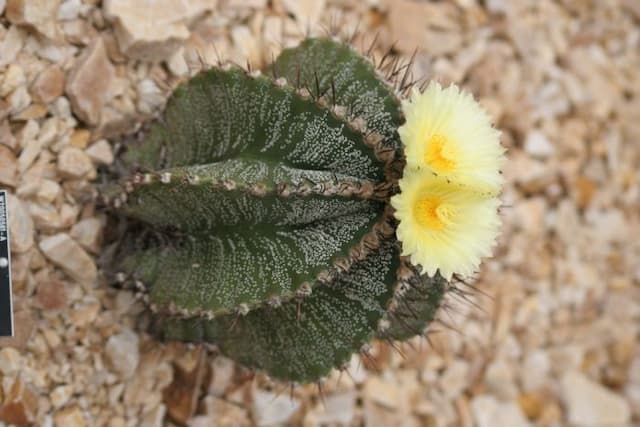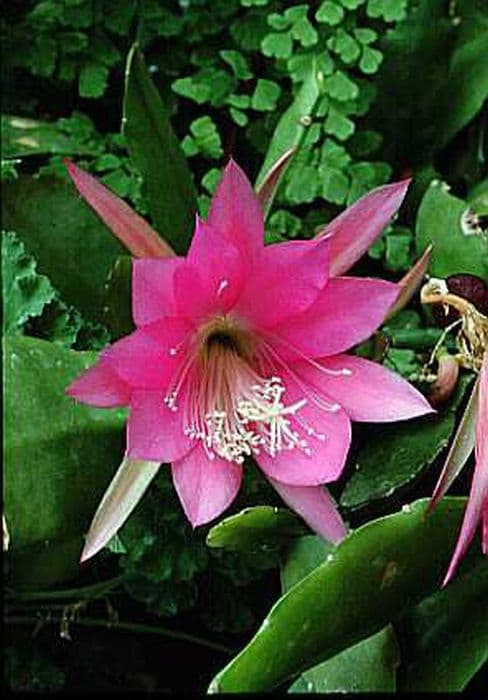Orange Snowball Rebutia mentosa

ABOUT
Rebutia mentosa, commonly known as the Crown Cactus, is a small, globular plant that tends to cluster, forming groups of rounded bodies. Its main feature is the copious amount of white, wool-like hairs that envelop the cactus, giving it a soft appearance as if it were dusted with snow or covered in frost. The hairs are particularly dense at the crown, hence its common name. The green to bluish-green flesh of the cactus is often obscured by these hairs. Amongst the downy covering, this plant sprouts vibrant flowers that can vary in color, often shades of orange, red, or yellow. These flowers emerge from the sides near the top of the plant's body, circling the cactus like a colorful necklace. The contrast between the bright flowers and the pale hairs is striking and adds to the plant's decorative appeal. The spines of the Crown Cactus are small and not particularly prominent, often hidden beneath the dense, cotton-like hairs. This adds to its friendly and inviting texture, making it a plant that's more approachable than many other spiky cacti varieties. With its compact and cuddly appearance, and the showy ring of flowers that it produces, the Crown Cactus is a charming and attractive addition to any collection of indoor plants or outdoor rock gardens in suitable climates.
About this plant
 Names
NamesFamily
Cactaceae
Synonyms
Hairy Crown Cactus, White Haired Crown, Woolly Rebutia
Common names
Rebutia minuscula, Rebutia minuscula var. mentosa, Rebutia senilis var. kesselringiana, Rebutia kesselringiana, Rebutia mentosa var. kesselringiana, Rebutia violaciflora.
 Toxicity
ToxicityTo humans
Rebutia mentosa, commonly known as the Crown Cactus, is not known to be toxic to humans. There is no significant information suggesting that this cactus is poisonous upon ingestion. Therefore, no symptoms of poisoning are generally associated with this plant for humans.
To pets
The Crown Cactus (Rebutia mentosa) is not considered toxic to pets such as cats and dogs. Ingestion of this cactus should not cause poisoning symptoms. However, as a general precaution, it's always best to prevent pets from ingesting plants as individual animals may have different sensitivities or allergic reactions.
 Characteristics
CharacteristicsLife cycle
Perennials
Foliage type
Evergreen
Color of leaves
Green
Flower color
Varies
Height
0.16 feet (5 cm)
Spread
0.16 feet (5 cm)
Plant type
Cactus
Hardiness zones
9
Native area
South America
Benefits
 General Benefits
General Benefits- Ornamental Appeal: Rebutia mentosa, commonly known as the Crown Cactus, adds aesthetic value to any space with its vibrant flowers and unique, globe-like form which can enhance the beauty of any garden or home interior.
- Easy to Care For: The Crown Cactus is known for being a low-maintenance plant, requiring minimal watering and care, making it an excellent choice for beginners or those with busy lifestyles.
- Drought Tolerant: Adapted to arid environments, this cactus is highly tolerant to drought, reducing the need for frequent watering and suitable for xeriscaping.
- Compact Size: The small size of the Crown Cactus makes it ideal for growing in containers, on window sills, and in areas where space is limited.
- Enhances Mental Wellbeing: Being around plants, including the Crown Cactus, has been shown to reduce stress levels and promote feelings of well-being.
- Promotes Biodiversity: When planted outdoors, the Crown Cactus can attract and support local wildlife, such as bees and hummingbirds, due to its flowers.
 Medical Properties
Medical PropertiesThis plant is not used for medical purposes.
 Air-purifying Qualities
Air-purifying QualitiesThis plant is not specifically known for air purifying qualities.
 Other Uses
Other Uses- Miniature Landscapes: Rebutia mentosa can be used in creating diminutive desert-like landscapes in terrariums and miniature gardening setups due to its small size.
- Photography Subjects: The bright and colorful flowers of the crown cactus make it a popular choice for macro photography and plant portrait sessions.
- Craft Projects: Dried flowers and small cactus plants like Rebutia mentosa may be incorporated into craft projects, such as making decorative wreaths or as adornments on gift wrapping.
- Education: These plants can be utilized in educational settings to teach about plant care, propagation, and the growth cycles of succulents.
- Stress Relief: Tending to a Rebutia mentosa can be a relaxing hobby that helps to alleviate stress and promote mindfulness.
- Office Decor: Because of their compact size, these cacti can be used to add a touch of greenery to office desks and workspaces without taking up much space.
- Collectibles: Enthusiasts may collect various species of Rebutia, including Rebutia mentosa, for their unique shapes and blooms, often showcasing them in cactus and succulent expositions.
- Therapeutic Gardening: Caring for these plants can be part of therapeutic gardening activities used to enhance physical, mental, and emotional well-being.
- Seasonal Gifts: The crown cactus, with its pleasant appearance, can be given as a living gift for occasions like Mother's Day, teachers' appreciation, or as housewarming presents.
- Feng Shui: Some practitioners may include Rebutia mentosa in arrangements to introduce elements of earth and wood into the home for balanced chi in Feng Shui practices.
Interesting Facts
 Feng Shui
Feng ShuiThe Crown Cactus is not used in Feng Shui practice.
 Zodiac Sign Compitability
Zodiac Sign CompitabilityThe Crown Cactus is not used in astrology practice.
 Plant Symbolism
Plant Symbolism- Resilience: Rebutia mentosa, commonly known as the Crown Cactus, often symbolizes resilience due to its ability to thrive in harsh, rocky environments and recover from tough conditions.
- Beauty in Adversity: The Crown Cactus blooms beautiful flowers despite its spiny exterior and the arid conditions it grows in, representing the concept of finding beauty and positivity amidst difficulties.
- Adaptability: Representing adaptability, this plant can survive in various temperatures and conditions, making it a symbol for the ability to adjust and flourish in different life circumstances.
- Self-Protection: With its spines, the Crown Cactus can symbolize the need for self-defense and setting boundaries, showing that it's necessary to protect one's space and well-being.
 Water
WaterThe Crown Cactus, commonly known as Rebutia mentosa, should be watered when the top inch of soil feels dry, which usually means once a week during the active growing season in spring and summer. During its dormant period in fall and winter, reduce watering to once every two to three weeks. When watering, provide enough water to soak the soil thoroughly until water runs out of the drainage holes, which might be around 10-12 ounces for a standard pot size. Avoid letting the plant sit in standing water as this can lead to root rot.
 Light
LightThe Crown Cactus thrives in bright, indirect sunlight and can tolerate direct morning sun. The best spot for this plant would be near a south or east-facing window with some form of light filtering to prevent scorching. It can also prosper under grow lights if natural light is not sufficient.
 Temperature
TemperatureThe Crown Cactus prefers consistent temperatures between 50°F and 75°F, and should not be exposed to temperatures below 40°F, as it can damage the plant. Ideally, maintain an environment that mimics its natural habitat, with daytime temperatures around 70°F and slightly cooler at night. Avoid placing it near drafts or heating vents to prevent sudden temperature fluctuations.
 Pruning
PruningPruning the Crown Cactus is generally not necessary as it maintains a compact form. If pruning is needed to shape or remove dead matter, it is best done in the spring before the growing season begins. Use clean, sharp tools to make any cuts and do so sparingly to avoid stressing the plant.
 Cleaning
CleaningAs needed
 Soil
SoilThe best soil mix for the Crown Cactus should be fast-draining with a mix of 50% mineral grit, such as coarse sand, perlite, or pumice, combined with 50% potting soil. A slightly acidic to neutral pH of 6.0 to 7.5 is ideal.
 Repotting
RepottingCrown Cacti should be repotted every 2-3 years or when they outgrow their current pot, to provide fresh soil and more space for the root system to grow.
 Humidity & Misting
Humidity & MistingCrown Cactus prefers low humidity levels, typical of arid environments, conforming well to average indoor humidity conditions.
 Suitable locations
Suitable locationsIndoor
Place Crown Cactus in bright, indirect sunlight and ensure good ventilation.
Outdoor
Grow Crown Cactus in bright shade or morning sun, and shelter from harsh conditions.
Hardiness zone
9-11 USDA
 Life cycle
Life cycleThe life cycle of Rebutia mentosa, commonly known as the Crown Cactus, begins with seed germination, which occurs when conditions are warm and lightly moist, generally in spring or early summer. After germination, the seedlings grow slowly, developing spines and the characteristic globular shape. In a few years, once mature, the Crown Cactus starts producing bright, showy flowers annually in late spring to early summer, often in shades of orange, red, or yellow. The flowers are followed by the development of small fruit that contains seeds, ready to be dispersed for the next generation. In cultivation, Rebutia mentosa may also be propagated vegetatively through offsets that form around the base, which can be separated and replanted. With good care, providing well-draining soil, ample sunlight, and minimal water, these cacti can live for many years, producing flowers and offsets throughout their lifespan.
 Propogation
PropogationPropogation time
Spring-Early Summer
The most popular method of propagating the Rebutia mentosa, commonly known as the Crown Cactus, is through offsets. This cactus tends to produce small pups around the base of the main plant, which can be removed and repotted to grow new plants. The best time to propagate is typically in the spring or early summer when the plant is actively growing. To propagate, carefully remove an offset that has developed its own roots. Allow the cut end to callous over for a few days to prevent rotting. Once calloused, plant the offset in a well-draining cactus potting mix, and water sparingly until you see new growth, indicating that the plant has rooted, which usually takes a few weeks. Care should be taken not to overwater the new plant, as Crown Cacti are susceptible to root rot in excessively moist conditions.









